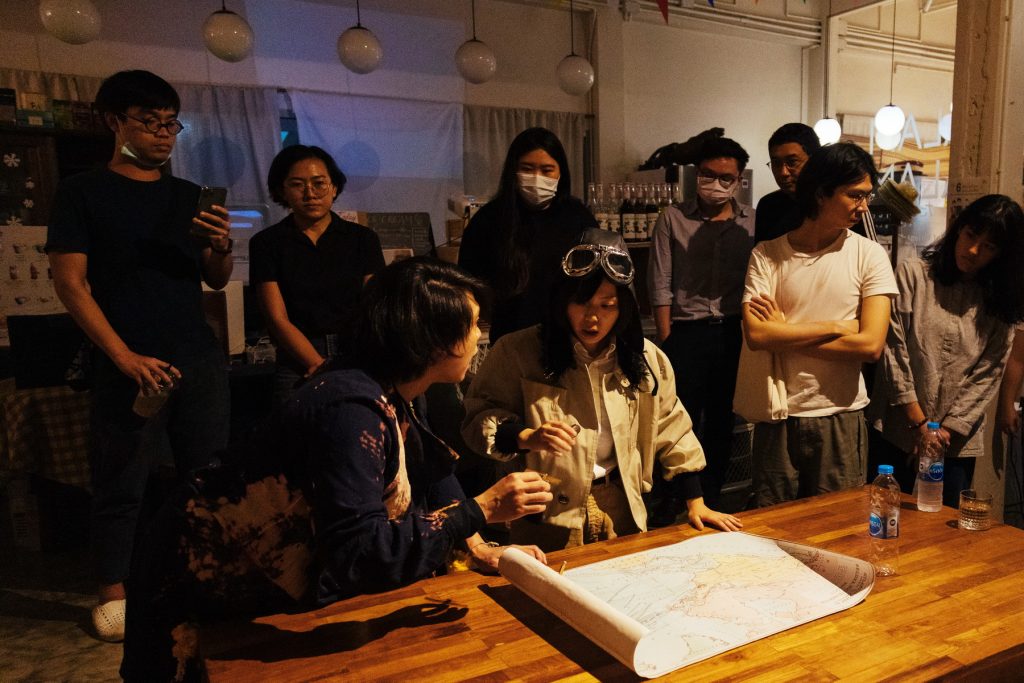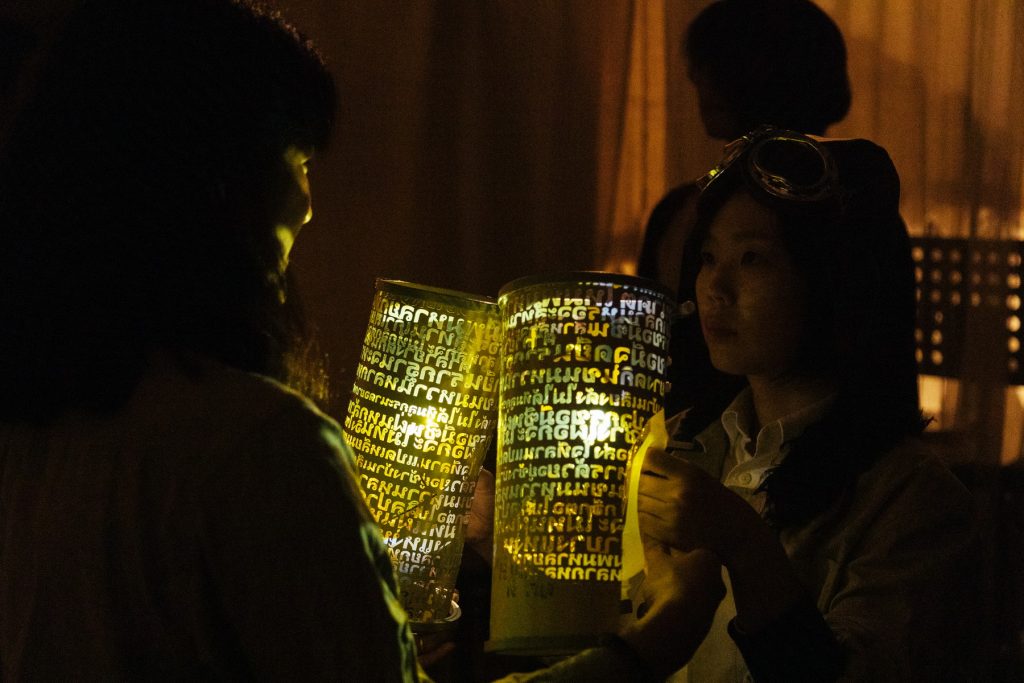LAST MONTH, BEFORE LIVE PERFORMANCES WERE BARRED, “LINDBERGH’S FLIGHT: A TRANS-ARCHITECTURAL JOURNEY”, AN INTERDISCIPLINARY COLLABORATION BY THAI AND JAPANESE ARTISTS RETOLD A TRANS-ATLANTIC VOYAGE. A SMALL GROUP OF AUDIENCES WENT THROUGH ALMOST EVERY SQUARE INCH OF SLURE: SPACE FOR ALTERNATIVE EXPLORATION, AND ONTO A SIDEWALK OF CHAROENKRUNG ROAD
TEXT: PAWIT MAHASARINAND
PHOTO: TEERAPHAN NGOWJEENANAN
(For Thai, press here)
You don’t have to be an avid theatergoer to know that one of the charms of this millennia-old art is the fact that the audiences and the artists share the space and time. In other words, in this age of social distancing, this art that promotes social inclusion has been strongly affected. Last month, after the cancellation of productions of large and medium scales and before the official prohibition of live performances, “Lindbergh’s Flight: A Trans-architectural Journey”, a work-in-progress, took off at Slure: Space for Alternative Exploration, on Charoenkrung road.
Created by Saitama Prefecture-based arts collective Gecko Parade, “Lindbergh’s Flight” is an adaptation of German dramatist Bertolt Brecht’s 1929 play “Der Lindberghflug”, an account of American aviator Charles Lindbergh’s historic solo trans-Atlantic flight from Long Island, NY to Paris, France. As part of their “trans-residential theatre” series, Gecko Parade, led by theater director Mizuhito Kuroda and scenographer and architect Mizuho Watanabe has staged this work in such non-conventional theater spaces as a house, a museum and a fermented soybean factory, and never before outside Japan.
Thanks to the collaboration of the Japan Foundation Bangkok, Slure Project and Prayoon for Art, the team behind the success of the last edition of Low Fat Art Fest, Gecko Parade became Gecko Parade and Co. Four Thai artists—namely filmmaker Chulayarnnon Siriphol, theater director and Silpathorn Award laureate Jarunun Phantachat, visual artist Sornchai Phongsa and cellist Saowakhon Muangkruan—joined the two Japanese directors, making this work a six-member team’s effort. Meanwhile, two Thai thespians accompanied two Japanese in this bilingual production.
It’s noteworthy that the original plan for this “trans-architectural journey” is for it to take place at Chulalongkorn University’s historic, and architecturally unique, Maha Chulalongkorn and Maha Vajiravudh Buildings, and their Life/Performance Festival, as part of “Cultural Ecologies of Performance” research project had already pledged their support. The university’s COVID-19 precautionary measures in late February made this impossible but the producers were efficient enough to move it to Slure, a two-unit, three-floor shophouse-cum-alternative-arts-space next door to another historic site of shipbuilding yard Bangkok Dock, and to limit the number of audiences to 10 per performance.
After the temperature check on all members of the audience—more than 10 on opening night—, the journey commenced on the ground floor as we gathered around the table where the Japanese actress in early 20th-century aviation suit introduced Lindbergh’s flight on the solo-engine “Spirit of St. Louis”, in Japanese with Thai and English surtitles from a mobile projector onto a wall. Her Thai counterparts had intermittent dialogues, narration and sometimes translation. The subsequent scenes took place in the hallways and rooms on the second and third floors and rubber sandals were provided for the audience. In this text-heavy play, Saiwakhon’s brief cello performance added musical pause, while Sornchai’s installation art work and Chulayarnnon’s short film infused, respectively, social and political commentary—all of their artistic contribution considerably brought this American heroic story closer to contemporary Thai audience. The final scene in which Lindbergh arrived at the Le Bourget Field after the trip that lasted almost 34 hours, was, to some passersby’ astonishment, on the sidewalk in front of Slure and Bangkok Dock. While some members might wish that such a historical site as the dock could have been part of this “trans-architectural journey”, we’re all inspired by the trans-Atlantic voyage and the multi-disciplinary performance carried out—against all odds—, and that never-say-die attitude we definitely could adopt in our fight against the pandemic.
While Kuroda and Watanabe’s use of space was deft, the stylistically and dramatically dense work didn’t allow much time for the audience to explore the architecture—some masked audiences evidently were more concerned about staying away from those unmasked strangers.
In other words, despite the promise, it fell short of being “site-responsive” and a more commonly used term for this kind of work would be “promenade performance”, which doesn’t promise an architectural tour, nor time for architecture to reflect its meanings. Also commendable was this rare opportunity for artists from different fields who have never worked together to do so; but instead of each being responsible for his/her scene, they should have sat down, brainstormed and co-created the entire work, had more time been allowed of course. Come to think of it, on the other hand, organizers of architectural tours should, also to expand the targeted participants, consider incorporating other relevant stories and art disciplines in this era when we’re promoting diversity and inclusion.
And because this was a work-in-progress, we’ll just have to see when and where “Lindbergh” will, post-COVID-19, take another daredevil flight in its full experimental form here in Thailand—hopefully sooner than later.




